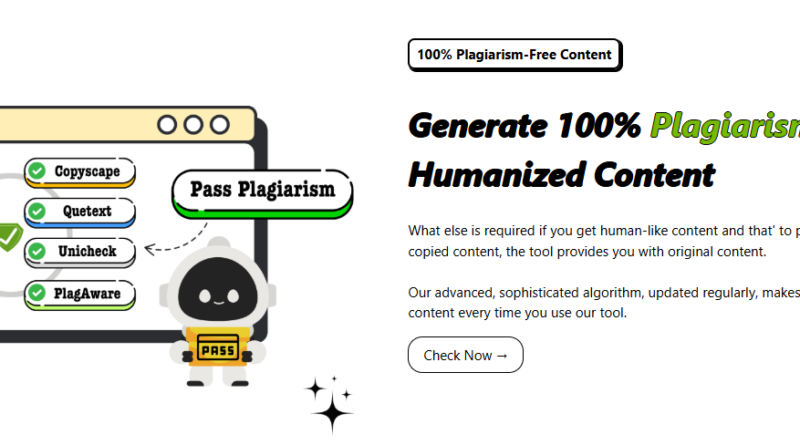AI Humanizer vs. Traditional Editing: A Detailed Analysis
AI has upended many industries, adding various forms of workforce operational efficiency. Among these innovations for humanizing AI-generated text, AI humanizers are particularly remarkable. How do these new tools stack up against old-fashioned editing tools?
This article provides a thorough comparison with a detailed understanding of benefits and drawbacks such as AI humanizer and manual editing and where they flourish.
Understanding AI Humanizer
An AI humanizer is a device that seeks to improve the AI-generated content to be more humanized and relatable. In simple words, it converts the text from AI to human. Using advanced NLP algorithms, this tool refines the tone, style, and flow of text to relate to human-fuelled norms of communication.
How AI Humanizer Works
An AI humanizer takes the AI-generated text, analyzes it for the context and intent, and then restructures it to make it more conversational and less robotic. For instance, customer response replies, content marketing materials, and educational material will benefit from the humanizer’s improved engagement and readability.
Key Features and Benefits
- Speed and Efficiency: AI humanizers take seconds to convert text, which makes them a perfect fit for time-sensitive projects.
- Consistency: They maintain a consistent tone and style throughout large volumes of content.
- Scalability: Capable of curating extensive content at any time, these are indispensable to organizations with large content libraries to handle.
Manual Editing: A Time-Tested Approach
Manual editing consists in the review and refinement of content by human editors. It relies upon their expertise to develop the language, structure, and overall quality of the entire piece.
Key Features and Benefits
- Nuanced Understanding
Editors do have the ability to understand the subtle contextual aspects that not all automated systems can encounter. - Creativity and Personalization
Human editors bring a different dimension of perspective and creativity to the text for one to be distinguished. - Complex Error Identification
Manual editing does a remarkable job when it comes to the identification of complex problems, such as the inconsistencies of flow-of-narratives or tones.
Pros and Cons of AI Humanizer
Pros of AI Humanizer
- Speed and Efficiency
One of the main selling points of AI humanizers is speed, enabling them to work within a fraction of the time taken by a human editor for refining content. Within just a few clicks, users can transform simple, AI-generated text into something human-like-suitable for any tight deadline or high-volume project. - Cost-Effectiveness
AI humanizers, on the other hand, provide a cost-effective solution to businesses creating a large volume of content. They obviate the need to hire several editors, with immense savings on operating costs without any compromise on core quality standards. - Scalability
AI humanizers can work with huge content production loads and are thus indispensable for organizations producing large volumes of content. Whether editing a huge amount of customer service responses or providing an edit to a few hundred blog posts, they are fast and can do a great deal in earnest. - Consistency in Output
Unlike human editors, where the fatigue factor or the incorrect mood may affect their performance, AI humanizers provide consistency through and through. Never again will a blog post have a different tone and style from the others, which is crucial in branding and customer communications. - Handles Repetitive Tasks
AI tools perform best on a series of simple, tedious tasks such as eliminating grammatical mistakes, establishing tone uniformity, or reformatting text. Although tedious for humans, these repetitive tasks are child’s play for AI.
Cons of AI Humanizer
- Lack of Deep Contextual Understanding
Automated systems are sometimes incapable of understanding the context of a text on a broad level. They may hence fail to interpret the subtle meanings of a message, the nuances associated with it, or its implied meanings, and as a result, will make mistakes outright, suggesting amendments which are less desirable or accurate. - Potential for Errors in Nuanced Language
AI humanizers never make sense of complex or nuanced language. Expressive terms, sarcasm, or cultural references tend to befuddle AIs and could lead them to edit in ways that may divert the meaning from what was precisely intended. - Limited Creativity
AI humanizers work within fixed algorithms that cannot produce original ideas or add a creative touch. This lack of flexibility often becomes very apparent when the text calls for a distinctive voice or innovative thinking. - Over-Reliance on Algorithms
Because AI relies on programmed rules, it may sometimes neglect less practiced but efficient styles of writing. Such inflexibility can stunt the individuality or personality of writing. - Inability to Handle Sensitive Topics with Care
Lacking in emotional intelligence, AI is unsuitable for editing highly sensitive and emotionally charged materials. Issues with this area would pose the risk of major blunders, turning any editing efforts drastically illegitimate.
Pros and Cons of Manual Editing
Pros
- Deep Contextual Insight
Human editors are good at deciphering contexts and adapting content to suit such. - Enhanced Creativity
Their ability to think outside the box adds value to creative projects. - Precision in Handling Sensitive Content
Humans are much better equipped to deal with sensitive, high-stake, or emotional content.
Cons
- Time-Intensive
Manual editing can be laborious and time-consuming. - Higher Costs
Employing skilled editors for large projects can be expensive. - Inconsistency in Output
The quality of editing can vary based on individual skill levels.
When to Use an AI Humanizer
An AI humanizer is best suited for:
- High-Volume Editing
When multiple pieces of content need refinement within tight deadlines. - Basic Editing Tasks
For tasks requiring minimal adjustments, such as ensuring consistency in tone and style. - Budget-Friendly Solutions
Ideal for organizations with limited resources seeking efficient results.
When to Choose Manual Editing
Opt for manual editing in cases where:
- Contextual Precision is Essential
Sensitive or nuanced content requires a human touch. - Creative Projects
High-quality, personalized content benefits from human creativity. - Critical Documents
When the stakes are high, such as legal or technical documents, human editors provide the necessary accuracy.
The Hybrid Approach: Combining AI Humanizer and Manual Editing
A hybrid approach combining AI humanizers with manual editing helps to maximize efficiency and quality.
Benefits of the Hybrid Model
- Efficiency through AI
Apply AI humanizers to do the drafts quickly and make sure basic grammar correctness and tonality enhancement for very large sets of data. - Precision and Depth with Human Editing
Human editors come after that step to further polish the content, adding creativity and cultural context to personalize the output. - Cost and Time Savings
While implementing this approach can cut the workload from human editors, it allows them to dedicate ample time on high-importance assignments while AI takes care of the repetitive aspects. - Consistency Across Content
AI tools assure uniformity, while human editors polish off the piece of communication to its topmost quality standards. - Scenarios for Application
- Customer Communications: AI humanizers would be able to ensure speed and uniformity while human editors refine sensitive or high-impact communications.
- Creative Projects: AI tools do the formatting and grammar, leaving important pieces to the human touch.
- High-Volume Content: For blogs or marketing campaigns, humanizers could allow mass management, while manual editing guarantees engagement and originality.
Comprehending the best and the limit of either of the approaches allows content creators to coexist together and make a powerful combination maximizing efficiency and quality. This hybrid model enables businesses to cater to the demands arising from the gamut of modern content types while keeping “human touch” at the core of communication.
Examples of Hybrid Workflows
- Initial AI Refinement
Use an AI humanizer to perform the first round of editing, focusing on grammar and tone. - Human Review
Follow up with a human editor to add depth, creativity, and cultural nuances.
The Role of AI Text Detector
As AI-generated content proliferates, AI text detectors have appeared to spot machine-generated content. Such tools are paramount in enforcing transparency and integrity, more so in fields like journalism and academia.
Conclusion
Each has its own edge of advantages, and what fits in well will wholly depend upon the unique needs of the project. AI tools can race through tasks with consistency and scalability, while human editing brings forth creativity, subtlety, and a human touch. It is for this reason that the hybrid approach that relies on the strengths of both methods becomes the best choice for many organizations.
The editing landscape, one that consists of AI technologies like AI humanizer, coupled with anything like AI text detector, is thus set for an ocean of changes. Content creators are thus free to leverage these innovations in conjunction with their traditional methods toward achieving the perfect balance between efficiency and quality. Whether you choose AI or manual editing-or a combination-the bottom line is still the same: to humanize content and make it speak to audiences.




